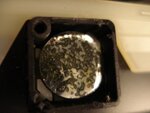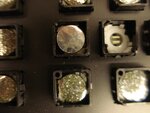neazoi
Advanced Member level 6
Hi I have a vintage PC-XT keyboard, the model Keytronic KB5151 pro series. The manual of the jr model is attached, which I suppose is the same.
The manual writes:
Capacitive key switches are used with a microprocessor performing
the functions of keyswitch scanning, translating keypresses to IBM
down-up scan codes, and maintaining bidirectional serial communica-
tions with the host computer.
The problem I have is with the switches. These have a metalized film as a contact element and the two contact electrodes for each key are formed onto the PCB. The metalized film reminds me the Mylar balloons.
Now this film has become like shown in the photo. The "metal" in it seems like it has evaporated and contacts cannot be achieved. The result is that almost all of the keys do not work because contact cannot be done.
5 years ago the keyboard worked, but I then stored it into a basement which was quite cold in the winter.
I am very considered about the safety of this film material. Is that possible that it contains some kind of mercury or other toxic substance that has vaporized or deteriorated throughout the years?
The manual writes:
Capacitive key switches are used with a microprocessor performing
the functions of keyswitch scanning, translating keypresses to IBM
down-up scan codes, and maintaining bidirectional serial communica-
tions with the host computer.
The problem I have is with the switches. These have a metalized film as a contact element and the two contact electrodes for each key are formed onto the PCB. The metalized film reminds me the Mylar balloons.
Now this film has become like shown in the photo. The "metal" in it seems like it has evaporated and contacts cannot be achieved. The result is that almost all of the keys do not work because contact cannot be done.
5 years ago the keyboard worked, but I then stored it into a basement which was quite cold in the winter.
I am very considered about the safety of this film material. Is that possible that it contains some kind of mercury or other toxic substance that has vaporized or deteriorated throughout the years?



